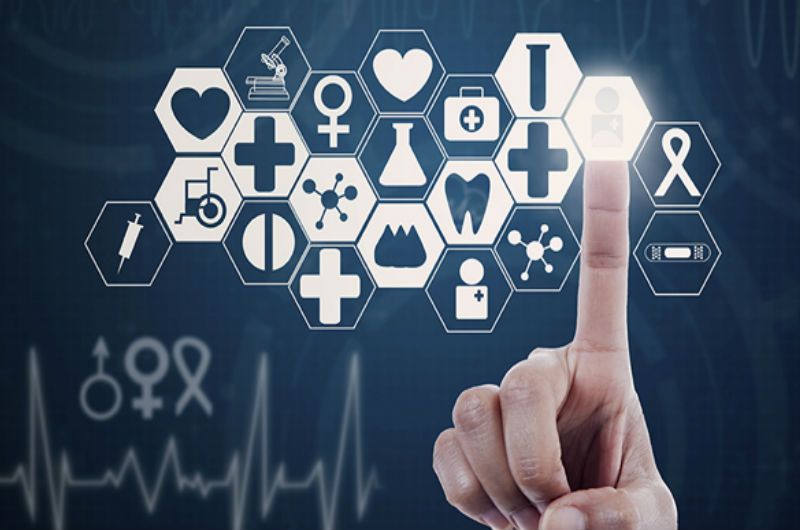Trends, Challenges and Opportunities in Online Healthcare Ecosystem

Source
Moving forward: Health 2.0
We entered the digital healthcare space involuntarily when the term health 2.0 was introduced in early 2000s. This was evidence enough that healthcare was predicted to join forces with the World Wide Web. Little did we know, fifteen years later there would be more ways than imagined to connect with potential patients.
Trends: Here’s what we know
When it comes to marketing, the healthcare industry lags behind by at least two years, but that doesn’t stop it from being a trillion dollar industry.
The Indian healthcare sector alone is estimated to touch $160 billion in 2017 – roughly double from what it was in 2012 (according to a report by Equentis Capitals) resulting in the CAGR growth rate of about 15%. There are a bunch of factors such as easier access to good healthcare services, relative increase in incomes and more emphasis on health awareness all contributing to this growth. Not just this, there is a significant demand in the quality of healthcare services in Tier-II and Tier-III cities which means people are recognizing the need for specialty-care.
India’s obvious advantage is the large pool of medical professionals and the dramatically lower medical costs as compared to other Asian and western countries. The surgeries reportedly cost one-tenth of that in US or Europe, making it a lucrative location for medical tourism and even R&D. Other than being widely known to be an English speaking country, alternative techniques like Ayurveda, Yoga and Unani make it stand out when compared to other competing south-east Asian and middle-eastern countries.
Digital Healthcare = Amplified Health Awareness
It is estimated that there will be over 550 million internet users in 2018.
Online healthcare has increased communication amongst various people. It is not only making doctors and hospitals more accessible to patients, it is also helping patients connect with other patients. People want to read real stories not just to be informed, but to be inspired. Furthermore, it is assisting people to learn more about their bodies and give all kinds of health information to potential patients- making them aware of treatment options and preventive measures.
Doctors are connecting with other doctors across the world. This global shift in digital healthcare is making it possible for people to receive more personalized and precise medicine and health services – reducing errors and cost, in turn, improving quality and providing easier access to medical facilities.
One of Twitter’s engineers dedicated to healthcare, Craig Hashi, says that there are about half a billion tweets that are sent out every day. Do you know what that means? In 2 years, there will be more words on Twitter than in all books ever printed!
Healthcare portals are making it possible for people to browse through top doctors, read patient feedback and book their next doctor’s visit with the click of a button.
Mobile apps are not only counting the calories of every meal you take, they are making it possible for you to monitor your pulse. Interestingly enough, studies suggest countries that have the highest daily app use also have the highest social media usage. These regions are fully adopting the concept of health 2.0, as a high percentage of consumers are not only viewing reviews but also giving feedback to doctors and hospitals using social media.
Opportunities
In India, there will be an estimated 200M smartphone users by 2016.
Evidently, Mobile marketing is already heading towards greater potential. Electronic medical records (EMR), mobile health (mhealth), telemedicine, and big data systems are technologies looking to have a great future.
A part of eHealth, telemedicine, is out to bridge the gap between the rural and urban. This will be done with the help of the Indian government that is working on a national project to provide healthcare facilities to the rural parts of the country. A successful example is that of Piramal e- Swasthya, established in 2008 in the hot state of Rajasthan that have treated almost a lakh patients since conception.
Challenges
Medical communities are interacting with the masses via millions of shares, likes and hashtags. However, this trend can also lead to misinterpretation so much so that people tend to self-diagnose and treat themselves. Medical professionals want people to understand that even though social media is resourceful, you should still see a doctor if you think you have a medical issue.
Healthcare portals are making it possible for people to browse through top doctors, read patient feedback and book their next doctor’s visit with the click of a button. Ravi Virmani, MD & Founder, Credihealth.com says, “The way internet penetration and awareness about health care is increasing in India, e-health care services would grow at a very healthy rate. I expect that very soon, it would contribute about 2 percent in the overall health care sector.”
So where does the real challenge for these startups lie?
Firstly, India is home to a majority of people who are referred to doctors by family and relatives or by word-of-mouth. Making people believe that their health issues can be handled through the internet is a real problem. Building trust among these people can spell great success for healthcare portals.
Another point to note is that there are several healthcare start-ups focusing solely on ‘booking appointments’, and not many players in the hospitalization space. In India, the domestic hospitalization industry is a total of $280 billion (according to a McKinsey report), while the international hospitalization industry is indicated to be about $4 + billion (according to a report by Ministry of Health/KPMG 2014). This means, massive business for start-ups like Credihealth, who are adopting hospitalization as their forté.
Talking futuristic: Smart technology
Wearables in healthcare have entered our lives. The Google watch, for instance, can measure your heart rate, track distances covered as well as keep you updated with news and emails. The watch is promising, yet leaves plenty to be done to create a more affordable and accessible device that caters to both urban and rural classes.
Google smart contact lenses are being engineered to take a person’s tears and measure their glucose level. This is the sort of futuristic health technology expected to make life easier.
While there’s no looking down for the healthcare industry, digital healthcare is emerging as the hero. Here’s to thousands of patients finding the right diagnosis, treatment and preventive measures online – this very minute.
Continue reading here: Tweeting, Posting, Pinning - How Social Media is Changing Healthcare
Was this article helpful?

